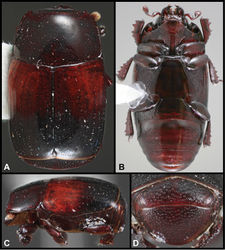Megalocraerus rubricatus
| Notice: | This page is derived from the original publication listed below, whose author(s) should always be credited. Further contributors may edit and improve the content of this page and, consequently, need to be credited as well (see page history). Any assessment of factual correctness requires a careful review of the original article as well as of subsequent contributions.
If you are uncertain whether your planned contribution is correct or not, we suggest that you use the associated discussion page instead of editing the page directly. This page should be cited as follows (rationale):
Citation formats to copy and paste
BibTeX: @article{Caterino2016ZooKeys, RIS/ Endnote: TY - JOUR Wikipedia/ Citizendium: <ref name="Caterino2016ZooKeys">{{Citation See also the citation download page at the journal. |
Ordo: Coleoptera
Familia: Histeridae
Genus: Megalocraerus
Name
Megalocraerus rubricatus Lewis, 1902 – Wikispecies link – Pensoft Profile
- Megalocraerus rubricatus Lewis, 1902: 231
Type material
Lectotype, here designated (BMNH): “Bresil”/”Jatahy, Prov. Goyas”. Although Lewis slightly differentiated the primary type locality in Goyas, his mention of a second specimen from ‘the Amazon Region’ leaves some room for ambiguity, which we address through this lectotype designation; cotype only “Bresil”.
Other material
Brazil (country record only; ‘Amazon Region’ as published; Lewis, 1902; BMNH). French Guiana: 1: Rés. des Nouragues, Régina, 4°2.27'N, 52°40.35'W, 10.x.2009, FIT, SEAG (CHND); 4: same locality and collectors, 3.xi.2009, (CHND); 1: Belvèdére de Saül, 3°1'22"N, 53°12'34"W, FIT, 17.ix.2010, SEAG (CHND).
Diagnosis
The type species is the most easily recognizeable in the genus, being at once the largest and most elongate, while also unique in its red basal elytral maculae. The basal sutural arch does not meet any of the other dorsal striae, whereas it is continuous with either the 4th or 5th dorsal stria in all other species.
Description
Size: Length 3.5–4.1 mm; width 2.3–2.6 mm; Body: elongate, parallel-sided, moderately depressed; castaneous with distinct red maculations on basal two-thirds of elytra. Head: Frons finely and doubly punctate, with medium punctures separated by about their diameters against fine ground punctation, decreasing in size but slightly increasing in density anteromediad; frontal stria present along inner margins of eyes, broadly interrupted across epistoma; supraorbital stria absent; epistoma depressed, narrowing anterad; labrum impunctate, but with fine microsculpture; mandibles each with inner marginal tooth. Pronotum: Pronotal sides weakly rounded, slightly narrowed anterad, marginal stria complete, lateral stria absent, fragments of anterior stria usually present; pronotal disk with small secondary punctures sparse basomedially, increasing in density toward front and sides, with fine ground punctation more or less uniform; larger punctures present along posterior margin. Elytra: Two complete epipleural stria present; subhumeral striae absent; dorsal striae 1–4 more or less complete, 5th stria obsolete near base, not meeting basal arch of complete sutural stria; bases of dorsal striae extending mediad along basal elytral margin, but only very rarely meeting base of next stria; ground punctation of elytral disk fine, small secondary punctures present in apical fourth. Prosternum: Prosternal lobe evenly rounded, complete to sides, with marginal stria usually obsolete at sides; prosternal keel with two complete carinal striae. Mesoventrite: Anterior mesoventral margin evenly emarginate, with complete, fine marginal stria; mesometaventral stria absent; disk with only fine ground punctation. Metaventrite: Metaventral disk finely punctate at middle, more coarsely so laterad lateral metaventral stria; postmesocoxal strial obscured by punctation. Abdomen: Abdominal ventrites rather coarsely but shallowly punctate throughout widths; propygidium transverse, about three times as wide as long, coarsely punctate, with punctures separated by slightly less than their diameters; pygidium similarly coarsely punctate at base, more finely and sparsely apicad. Male: 8th tergite with deep, rather narrow basal emargination, ventrobasal processes nearly meeting, dorsally with fine median emargination; halves of 8th sternite approximate along much of midline, apicomedial processes rather narrow, subacute; 9th tergite with acute, incurved apices; spiculum gastrale (S9) broad throughout, slightly narrowed at neck, apex shallowly emarginate; 10th tergite with median basal emargination; aedeagus flattened throughout, sides weakly rounded, apices slightly separated; median lobe slightly more than one-half tegmen length.
Remarks
While previously the only exemplar of the genus, Megalocraerus rubricatus is atypical of the group in a number of ways, being significantly larger, flatter, and with distinctive coloration. It is easily recognized in the group.
Taxon Treatment
- Caterino, M; Tishechkin, A; 2016: A revision of Megalocraerus Lewis, 1902 (Coleoptera, Histeridae: Exosternini) ZooKeys, (557): 59-78. doi
Images
|




